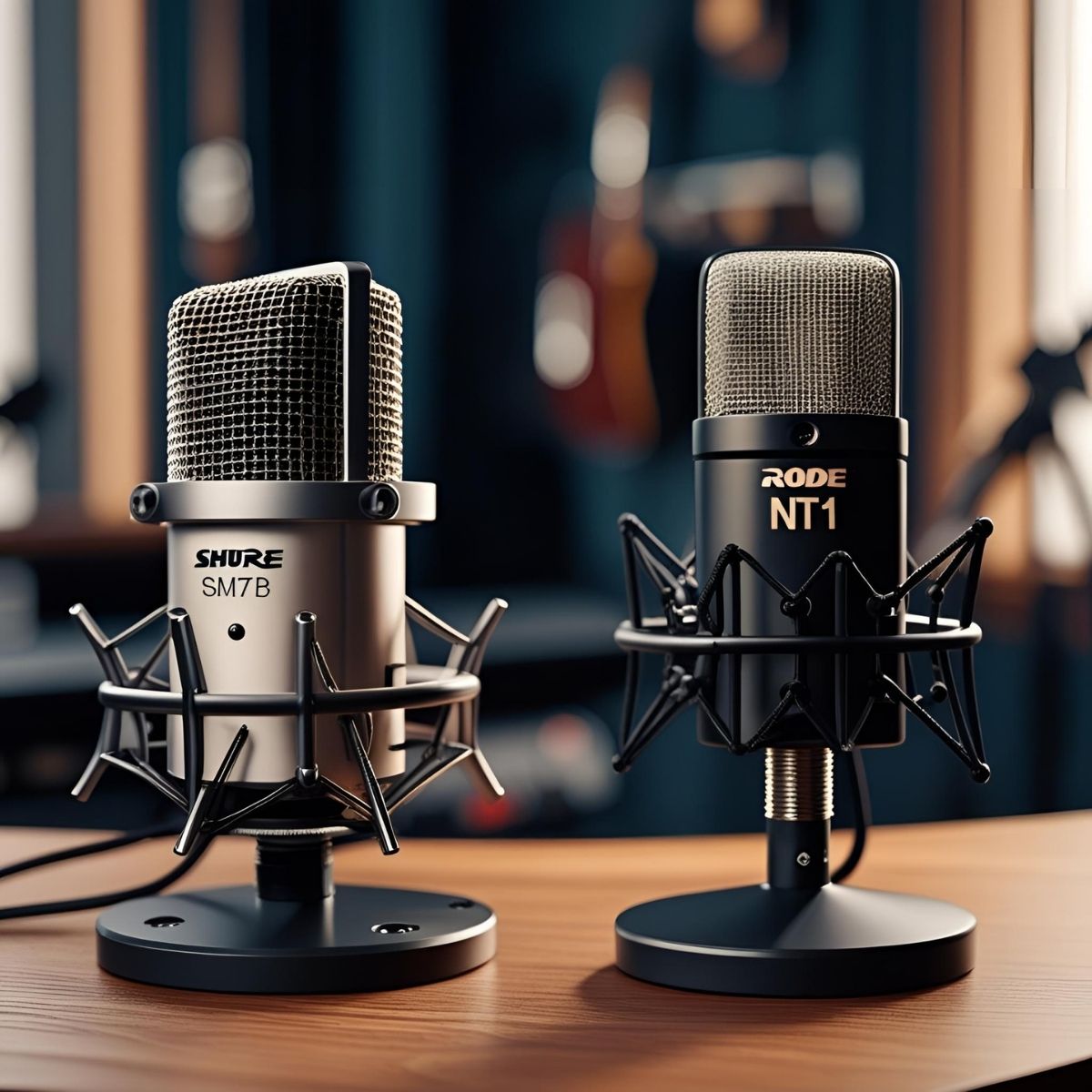
Shure SM7B vs Rode NT1

Achieving professional-sounding vocals is often the holy grail for home studio enthusiasts, podcasters, and streamers. You can have the best instruments and the most creative ideas, but if your vocals sound thin or muddy, your entire production suffers. In this pursuit, two microphones consistently rise to the top of discussions, igniting passionate debates: the Shure SM7B and the Rode NT1. Despite their fundamental differences, both are celebrated for their ability to deliver exceptional vocal recordings.
This guide will pit these two vocal powerhouses against each other, dissecting their strengths, weaknesses, and ideal use cases. We’ll explore their microphone type, unique sound signatures, what kind of recording environment they thrive in, the extra gear you might need, their overall versatility, and, of course, the cost. By the end, you’ll be equipped to decide which one is the definitive choice for your vocal recordings.
Choosing Your Champion: Shure SM7B vs Rode NT1

When it comes to selecting the Best Vocal Microphone for your setup, the debate often boils down to the Shure SM7B vs Rode NT1. This Studio Microphone Comparison is crucial for anyone serious about audio, whether you’re setting up a dedicated Podcast Microphone, a professional Streaming Microphone, or a versatile Vocal Recording Mic for music. The fundamental difference lies in their design: the Dynamic vs Condenser Mic debate dictates their sensitivity, ideal environment, and overall sound character. Ultimately, the choice between the rugged, noise-rejecting warmth of the SM7B and the detailed, pristine clarity of the NT1 depends heavily on your specific recording space and vocal needs.
Contender 1: The Shure SM7B – The Broadcast Legend
First up is the Shure SM7B, a microphone that has graced countless radio booths, podcast studios, and even famous vocal tracks (think Michael Jackson’s Thriller). It’s a dynamic microphone, meaning it uses a robust coil and magnet assembly to convert sound waves into electrical signals. This design makes it incredibly rugged and less sensitive to subtle sound nuances than condenser mics, which can be a huge advantage.
Key Characteristics for Vocals:
The SM7B’s sound signature is instantly recognizable: warm, smooth, and rich, often described as having that quintessential “radio-ready” broadcast sound. It’s excellent at taming harsh frequencies, making even energetic vocal performances sound polished and controlled. You can also leverage its proximity effect—the natural increase in bass response as you get closer to the mic—to add a deep, resonant quality to your voice, perfect for that intimate podcast feel. For further tonal shaping, the SM7B includes built-in EQ switches: a bass roll-off to reduce muddiness and a presence boost to add clarity and punch to vocals.
Ideal Recording Environment:
This is where the SM7B truly shines for home studio users. Its exceptional off-axis rejection means it primarily picks up sound directly in front of it, largely ignoring noises from the sides and rear. This makes it a superhero in untreated or noisy rooms, minimizing background chatter, computer fan hum, and unwanted room reflections. If your recording space isn’t acoustically perfect, the SM7B is incredibly forgiving.
Required Gear:
A crucial point to note is the SM7B’s low output level. It typically requires a high-gain preamp (around +60dB or more) to truly come alive. While some modern audio interfaces can provide this, many entry-level ones might struggle, leading to a noisy signal. You might need an inline preamp like a Cloudlifter or FetHead to boost the signal cleanly before it hits your interface. This extra piece of gear adds to the initial cost but is often essential for optimal performance.
Pros for Vocals:
- Exceptional noise rejection for untreated rooms.
- Delivers a smooth, warm, and rich tone.
- Great for aggressive or loud vocals, preventing harshness.
- Incredibly durable and built to last.
- Possesses an iconic and professional sound.
Cons for Vocals:
- Requires significant clean gain, potentially needing an additional inline preamp.
- Less detailed and “airy” compared to condenser microphones.
- Can sound a bit “dark” or “muffled” on some voices if not properly EQ’d or paired with the right preamp.
- Less sensitive, meaning it’s less ideal for capturing subtle vocal nuances from a distance.
Contender 2: The Rode NT1 – The Studio Silencer
Next in the ring is the Rode NT1, a condenser microphone revered in home studios worldwide for its pristine sound. Unlike dynamic mics, condenser microphones operate by using a thin, conductive diaphragm positioned close to a charged backplate. This design makes them far more sensitive and capable of capturing intricate details and a wider frequency range, but it also means they’re more susceptible to their surrounding acoustics.
Key Characteristics for Vocals:
The NT1’s sound signature is known for its crystal-clear, detailed, and incredibly accurate reproduction. It delivers a natural and transparent sound, making your vocals sound just as they do in real life, but better. A standout feature is its exceptionally low self-noise—it’s one of the quietest microphones on the market, meaning you’ll capture more of your voice and less of the mic’s own electronic hum. Its frequency response is relatively flat, with a subtle, natural “airiness” in the high end, which can add a lovely sparkle to vocals.
Ideal Recording Environment:
Given its high sensitivity, the Rode NT1 truly excels in acoustically treated environments. In a quiet room with proper sound absorption and diffusion, the NT1 can capture every nuance of a vocal performance, from the softest whispers to the most powerful belts, without picking up unwanted room reflections or ambient noise. If your space is not treated, its sensitivity might mean it picks up too much of your room’s natural reverb or background sounds, which can muddy your recording.
Required Gear:
As a condenser microphone, the Rode NT1 requires phantom power (48V), which is typically supplied by your audio interface. Most modern interfaces come equipped with this. However, to truly get the most out of its sensitive nature, acoustic treatment for your recording space is highly recommended. This might involve acoustic panels, bass traps, or even just blankets and soft furnishings to dampen reflections.
Pros for Vocals:
- Offers incredible clarity and detail, capturing subtle vocal nuances.
- Features extremely low self-noise, resulting in clean recordings.
- Great for breathy or delicate vocals, where transparency is key.
- Often comes as a complete kit, including a high-quality shock mount and pop filter, adding value.
Cons for Vocals:
- Highly sensitive to room acoustics and background noise, requiring a quiet and often treated recording space.
- Can sometimes sound a bit “harsh” or “sibilant” on certain voices if not properly managed with microphone technique or post-processing.
- Generally more fragile than dynamic microphones, so it requires careful handling.
4. Head-to-Head Comparison: The Ultimate Showdown for Vocals
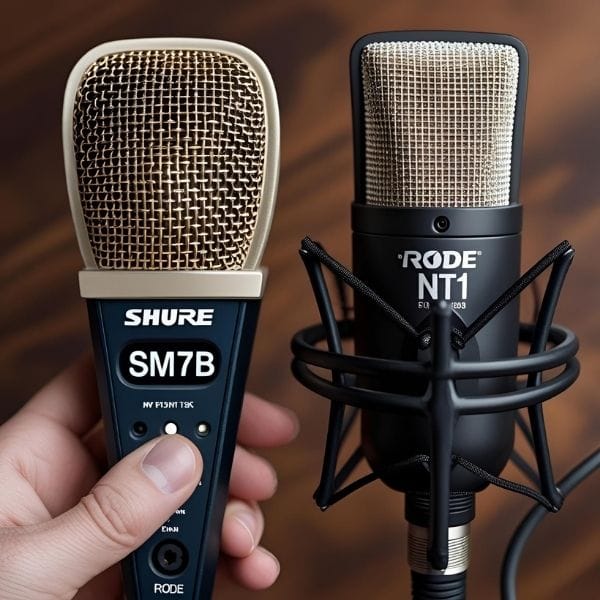
To truly understand the choice between the Shure SM7B and the Rode NT1, let’s put them side-by-side. While both are fantastic microphones for vocals, their strengths lie in different areas, making one a better fit for your specific needs than the other.
Here’s a quick overview, followed by a more detailed breakdown:
In-Depth Breakdown:
- Microphone Type: This is the foundational difference. The SM7B is dynamic, built to be rugged and less sensitive. The NT1 is condenser, designed for sensitivity and capturing fine detail. This fundamental difference dictates much of their performance.
- Sound Character: The SM7B delivers that classic warm, smooth, and rich broadcast sound. It’s forgiving and flattering, often making voices sound instantly professional without much processing. The NT1, on the other hand, is all about crystal-clear, detailed, and natural transparency. It aims to capture your voice exactly as it sounds, with all its nuances and “air.”
- Noise Rejection: This is a major battleground. The SM7B excels at rejecting off-axis sound, making it a dream for noisy or untreated rooms. It’ll focus tightly on your voice, minimizing background hums, keyboard clicks, or room echo. The NT1, while having very low self-noise, is highly sensitive to room acoustics. It’ll pick up almost everything in your room, making acoustic treatment nearly essential for clean recordings.
- Gain Requirement: The SM7B is notorious for needing a lot of clean gain (often 60dB or more). Without a good preamp or an inline booster like a Cloudlifter, it can sound weak or noisy. The NT1 has a much higher output and only needs standard 48V phantom power, which most audio interfaces provide easily.
- Ideal Room: If your recording space is untreated, noisy, or has a lot of reverb, the SM7B is usually the safer bet. If you have an acoustically treated, quiet room, the NT1 will shine, capturing pristine audio.
- Detail Capture: The NT1 is exceptional at capturing micro-details, subtleties, and the “air” around a vocal performance. It’s great for intricate singing or detailed voiceovers. The SM7B captures good detail, but its inherent smoothness means it might mask some of the very fine nuances that a condenser picks up.
- Plosive Control: Both mics are good here. The SM7B has fantastic built-in pop filtering due to its design. The NT1 often comes with a very effective external pop filter, but its sensitivity still means you need to be mindful of “p” and “b” sounds.
- Durability: The SM7B is legendary for its durability; it’s practically a tank and can withstand a lot of abuse. The NT1 is also well-built but, as a condenser, is inherently more delicate and should be handled with more care.
- Price Point: The SM7B is typically in the mid-to-high range, and you need to factor in the potential extra cost of a powerful preamp. The NT1 is usually in the mid-range for condensers, offering excellent value as it often comes as a kit with essential accessories.
- Typical Use: The SM7B is the go-to for podcasting, streaming, and broadcasting, and a favorite for rock/metal vocals due to its ability to handle loud, aggressive voices. The NT1 is a workhorse for studio vocals (singing, voiceovers) where clarity and detail are paramount, and it also excels on acoustic instruments.
5. Beyond the Mic: Your Vocal Chain Matters
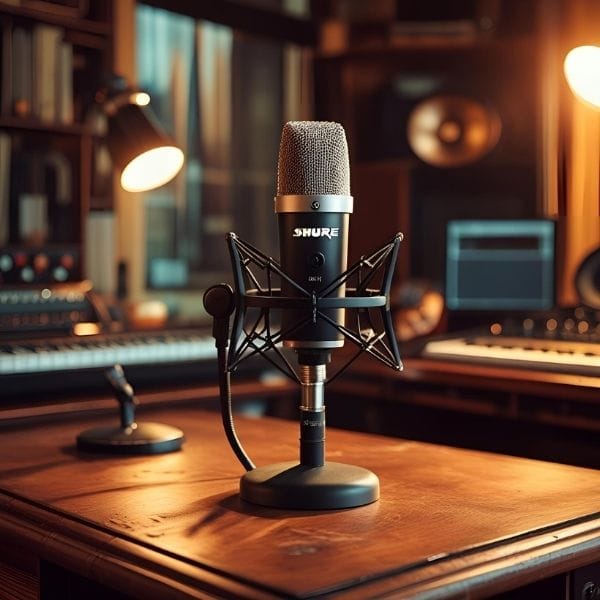
Choosing the right microphone is a critical first step, but it’s just one link in the chain that delivers your vocal performance to your audience. The surrounding gear and your recording practices play an equally vital role in shaping the final sound.
Audio Interface: Your Gateway to Digital Sound
Both the Shure SM7B and the Rode NT1 connect to your computer via an XLR input on an audio interface. This device acts as the bridge, converting the analog signal from your microphone into a digital signal your computer can understand.
For the Shure SM7B, the quality and gain output of your interface’s preamp are paramount. As a low-output dynamic mic, the SM7B demands a significant amount of clean gain (often +60dB or more). An interface with weak or noisy preamps will result in a thin, hissy, or simply too quiet signal. Investing in an interface known for its robust preamps (or adding an inline preamp like a Cloudlifter or FetHead) is often essential to unleash the SM7B’s full potential.
The Rode NT1, being a condenser, requires 48V phantom power (which most modern interfaces provide) and has a much higher output level. While a good preamp is always beneficial, the NT1 is generally more forgiving with a wider range of interfaces, sounding clean and clear even with more budget-friendly options.
Acoustic Treatment: Taming Your Room’s Sound
This is arguably as important as the microphone itself. Every room has its own acoustic characteristics – reflections, echoes, and standing waves – that can negatively impact a recording.
While the Shure SM7B is impressively forgiving in untreated or noisy environments due to its excellent off-axis rejection, acoustic treatment will always improve your recordings for both microphones. By reducing unwanted reflections, you gain more control over the sound in post-production.
For the Rode NT1, acoustic treatment is almost a necessity. Its high sensitivity means it will pick up every nuance of your room, including reverb, echoes, and background noise. Without treatment, even the cleanest vocal performance can sound distant, muddy, or unprofessional. Investing in acoustic panels, bass traps, or even just strategically placed blankets can make a dramatic difference.
Microphone Technique: The Human Element

Even with the best gear, poor microphone technique can ruin a take. Learning how to properly use your microphone is crucial:
- Distance: The distance between your mouth and the microphone significantly impacts the sound. Closer generally means more bass (proximity effect, especially with the SM7B) and less room sound; further away means a more natural sound but also more room influence. Experiment to find the sweet spot for your voice and mic.
- Angle: Aiming the microphone directly at your mouth can cause harshness or excessive plosives (P and B sounds). Angling the mic slightly off-axis can help tame these issues.
- Pop Filter: An essential accessory for virtually any vocal recording. A pop filter (either internal like on the SM7B or external for the NT1) prevents harsh “pops” from breath hitting the microphone diaphragm directly, protecting your recording from distracting artifacts.
- Controlling Dynamics: For singers, learning to move with the mic (e.g., pulling back slightly on loud notes) can help maintain consistent levels and avoid distortion.
Microphone technique is essential for both mics, but it’s particularly critical for the sensitive Rode NT1, where every slight movement or room nuance will be captured with fidelity.
Post-Production: Polishing Your Performance
It’s a common misconception that a perfect microphone means no need for mixing. The truth is, no mic is perfect out of the box, and post-production is where your raw vocal track is polished into a professional-sounding element of your final mix.
- EQ (Equalization): Used to sculpt the tonal balance of your vocal. You might use EQ to remove muddy low-mids, add clarity to the upper mids, or brighten the highs.
- Compression: This reduces the dynamic range of your vocal, making the loud parts quieter and the quiet parts louder, resulting in a more consistent and present vocal that sits well in a mix.
- De-essing: An indispensable tool to tame harsh “s” and “sh” sounds (sibilance) that can become exaggerated, especially after EQ and compression. Both the SM7B and NT1 can benefit from de-essing depending on the vocalist.
Mastering these post-production tools is vital for achieving broadcast-quality or studio-quality vocals, regardless of which excellent microphone you choose.
6. The Verdict: Which Mic Wins the Showdown?
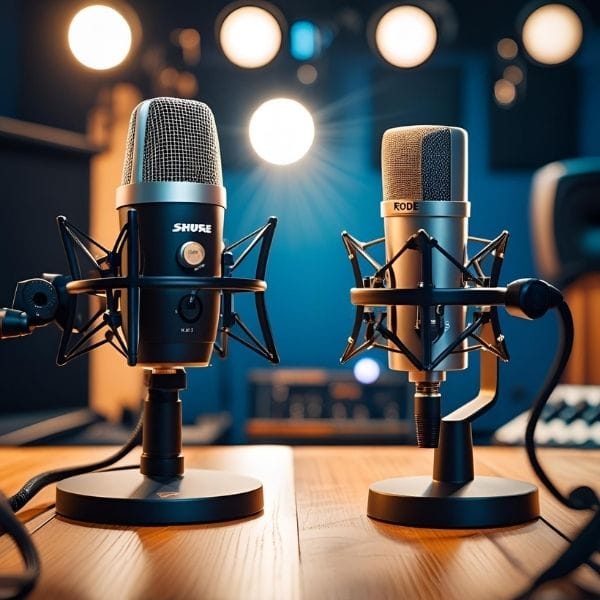
After breaking down the intricacies of the Shure SM7B and the Rode NT1, it’s clear there’s no single “winner” in this ultimate vocal showdown. Both microphones are titans in their respective classes, excelling in different scenarios and often complementing different vocal characteristics. The “better” mic isn’t about raw specs, but about finding the right tool for your specific needs, environment, and artistic vision.
Recommendation for Untreated Rooms & Broadcast-Ready Sound: The Shure SM7B
If your recording space is not acoustically treated, if you deal with consistent background noise (like a noisy computer, street sounds, or lively roommates), or if your primary goal is a rich, smooth, “radio-ready” broadcast vocal for streaming, podcasting, or loud singing (rock, metal, aggressive rap), the Shure SM7B is often the safer, more consistent, and arguably more forgiving choice.
Its unparalleled off-axis rejection and inherent sound shaping qualities allow it to deliver clean, polished vocals even in less-than-ideal environments, reducing the headache of extensive post-production noise reduction. Just remember to factor in the potential need for a high-gain preamp!
Recommendation for Treated Rooms & Detailed Studio Vocals: The Rode NT1
Conversely, if you have access to a quiet, acoustically treated space and your priority is capturing every nuance, pristine clarity, and “airy” detail in a vocal performance, the Rode NT1 offers incredible value and pristine results.
It’s a fantastic choice for studio singing (especially for genres like pop, R&B, jazz, or acoustic), voiceovers where every subtle inflection matters, or rap vocals that demand crisp articulation. The NT1’s low self-noise and transparent sound will make your vocals sound incredibly professional, provided your room allows it to shine without picking up unwanted ambient sounds.
Consider Your Voice: The Personal Element
Ultimately, a microphone’s sound signature also interacts uniquely with each individual’s voice. Some voices naturally sound great on the SM7B’s warmth, while others thrive on the NT1’s clarity. If possible, try to test both microphones with your own voice to hear which one resonates best with your unique timbre and delivery style.
Final Thought:
The decision between the Shure SM7B and the Rode NT1 boils down to a crucial assessment of your recording environment, your vocal style, and your production goals. Choose the mic that best complements your voice, your recording environment, and your production goals, and you’ll be well on your way to achieving professional-sounding vocals.
Further Reading: Master Your Vocal Recordings

Ready to refine your vocal chain and make an informed decision between these legendary microphones? Explore these additional resources:
📚 Internal Links: More from Gear For Audio
- Eliminate Echo & Reverb in Home Recording
- Best USB Microphones for Streaming and Podcasting
- Top Audio Accessories for Home Studios in 2025
- Audio Cables and Adapters Guide
🔗 External Links: Trusted Resources for Microphones & Audio
- Shure SM7B Official Product Page: Get the full specifications and details directly from the manufacturer: Visit Shure SM7B
- Rode NT1 Official Product Page: Explore the features and technical data of the Rode NT1: Visit Rode NT1
- Sweetwater’s Microphone Buying Guides: A comprehensive resource for understanding different microphone types and applications: Explore Sweetwater Mics

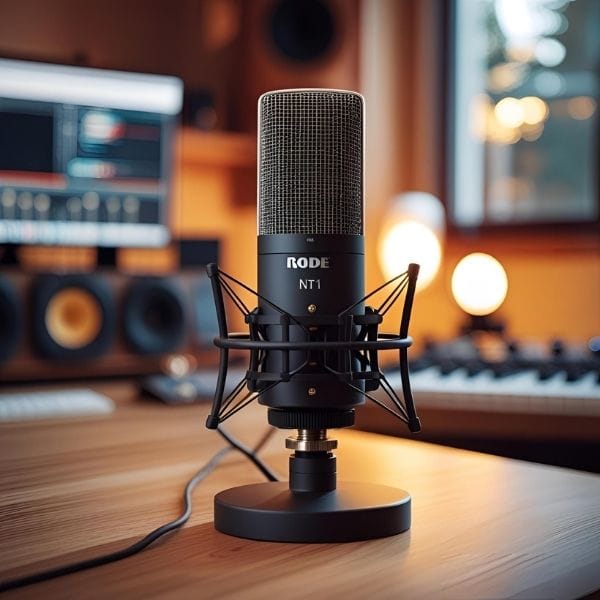

Pingback: Top 5 Best USB Microphones For Streaming & Gaming (2025): Crystal Clear Audio On Budget!